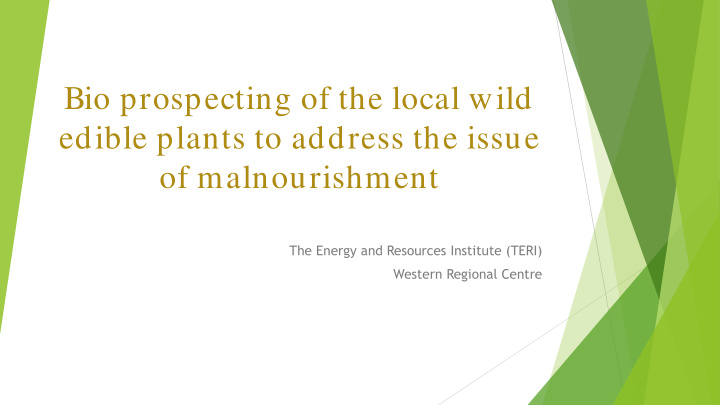



Bio prospecting of the local wild edible plants to address the issue of malnourishment The Energy and Resources Institute (TERI) Western Regional Centre
Rationale Malnourishment is a serious issue in rural as well as urban areas. The key reasons is due to lack of diversity in the diet and proper awareness about it. Rural communities have the resources but do not have proper awareness about it regarding its nutritional aspects while the urban dwellers have the capital resources but lack the knowledge. These common issue of concern be are complementary to each other. Urban people are unaware of the wild edibles and possess lack of confidence to consume it due to scanty information on it. Lack of transfer of the traditional knowledge from the elder generation to the young. Traditional knowledge would die off if not documented properly. How could we bridge the information gap on wild edibles and make it available was the question faced?
Approach: Documentation and scientific validation of the species Transect and Quadrat surveys Literature review Source : 1https://www.google.co.in/search?q=review+of+literature &rlz=1C2GIGM_enIN666IN666&biw=1366&bih=667&source=l Discussions with tribal nms&tbm=isch&sa=X&sqi=2&ved=0ahUKEwja7Z_11o_LAhUL WI4KHUnzBx0Q_AUIBigB#tbm=isch&q=proximate+analysis& Nutritional analysis communities and botanists imgrc=OnleDwzQfxcWsM%3A 2. https://www.google.co.in/search?q=review+of+literature &rlz=1C2GIGM_enIN666IN666&biw=1366&bih=667&source=l nms&tbm=isch&sa=X&sqi=2&ved=0ahUKEwja7Z_11o_LAhUL WI4KHUnzBx0Q_AUIBigB#imgrc=xeRw3PVGF_FWjM%3A
Impacts of the Project Documentation of 160+ species of dietary as well as medicinal significance.
Nutritional Analysis of the species D. wallichi S. sweitenoides Parameters Assessed 1. Total Fat 2. Proteins 3. Carbohydrates 4. Calorific Value L. macrophylla J. procumbens 5. Moisture 6. Ash 7. Crude Fiber 8. Free Sugars 9. Calcium 10. Phosphorous A. peltata A. hohenakarianum 11. Magnesium 12. Potassium 13. Vitamin A 14. Vitamin C 15. Iron 16. Starch
Wild plant nursery Conservation of germplasm of around 70 species of wild edible plants
Development of a Digital library on wild edible plants www.wildedibles.teriin.org Nutritional and medicinal information Map Uses Method of cultivation Method of preservation Toxicity and so on
Beneficiaries Governme ntal organizati ons Other Rural as Digital stakehold well as ers such Library urban as NGO’s people and so on Scientist and Students
Impacts of Digital Library Government and Non- Tribal communities Governmental organisations Benefited by the project as their Understanding the significance of the wild traditional knowledge would be conserved would help them address issues such as in digital repository. nutrition more effectively. Integration of this concept of wild plant in their initiatives by developing nutritional products, spreading awareness among the tribal communities and so on which shall benefit the tribal communities. Students and Scientists Urban dwellers Directly use of the information on wild Directly access to the information on plant species for research/ study wild plant species. purposes related to nutrition which The information shall increase their could of benefit to tribes. confidence on the consumption of the wild plant species and increase the diversity of nutrition in their diet of the urban dwellers as well.
Thank you
Recommend
More recommend